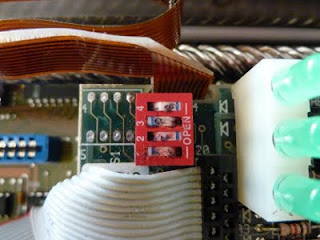In the new year I decided to further develop my SolarLight, I had to build a rigid rig to hold the light over my peppers vase. After some thought I decided to use plastic (polystyrol) to keep it lightweight. I used standard PVC glue (used for water/sewage pipes or spudguns) and Polystyrene.
To cut the boards I used standard hand tools (hand saw, metal file and sandpaper), thinking back I would be better off if I had used a table saw... With a good saw and speed setting I think I could do it all in one. I don't have a table saw, nor the space for it, maybe I'll use the Dremel mini-saw adaptor (
Dremel 670) or one of the
Proxxon mini/micro table saws.
The glueing of the parts was fast and clean, if you do something like this remember to do it out in the open or in a well ventilated place, toxic fumes come out while the parts are being chemically soldered. I found most of the plastic sheets and profiles
here.

I started out by trying one of the few available 2D-CAD packages for linux, I used
QCAD community edition that had a pre-compiled for my OpenSuse11.3 in the contrib repository. Learning a new tool has always it's steep learning curves, but I got what I wanted. I will try to use it for my future mechanical drawings of cases and front panels.


After the assembly I noticed that I forgot some openings for the LED connector and fixing, so it is just hanging for now. I also changed the battery pack I had for a 3x AA NiMH 2300mAh batteries. This was a
mistake, the
solar cell was selected based on a battery capacity of around 700mAh (an old NiCd pack I had laying around) and size of the board. Although with the batteries charged I got a good hour and a half of light, the next recharge period was a full week... from
this page I would need 40 hours of sunlight to fully charge the battery as the solar panel output current is below the C/40 ratio... Taking into account that the
average daily sunlight time of about 8h,(and in my south facing flat it's reduced to 4-5), that in Holland the sky is mostly cloudy for days in a row, that the solar cell outputs roughly 15mA with direct sunlight, I could expect to have a fully charged battery (with the NiMH pack) every two weeks.. With the NiCd I could expect once two sunny days (more or less what I was looking for). So I have to go back to smaller batteries, probably another junk 3x AAA NiCd pack I have around.
I also roughly measured the efficiency of power supply and made some tests. The maximum output current I managed was 700mA, more than that and the battery voltage would hit the under voltage protection I had built in, this is about 50% of the LEDs Power. I also had to add a heatsink to the LED as its temperature was rapidly increasing beyond the "can you touch it" capability (a rule of thumb I learned...). So I used a stable DC power supply and varied the input voltage, input current, output voltage and output current at about 25% LED power level (3.2V@300mA). The results are a bit disappointing, the efficiency is about 50% from the calculated 70%. I don't think the losses are semiconductor related but mostly the passive components (inductor resistance and capacitor inductance and resistance). The good point is that output voltage is mostly independent of input voltage...

I also did some improvements on the code and ordered some new SMD components, I'm planing on building a SMD version and extend the project to a bike light (with the electronics inside the lamp's casing), we'll see how that goes, later I'll publish the updated software.
I included a graceful degradation system to reduce the output power as the battery depletes its charge, the processor now sleeps between ADC conversions both to save power and reduce noise (I cannot disable the Timer as the PWM must run), I changed the charging process but not counting the hours of charge but only by checking the battery voltage as this allows an external charger (not sun) and finally I converted the code to be compile in linux (avr-gcc/gas).
It's a long post and I have some more post hanging in for further editing.. I'll try to keep up with one a week and I'm already falling behind.




 And now I'm ready for the harsh weather with the Kronan again...
And now I'm ready for the harsh weather with the Kronan again...












































